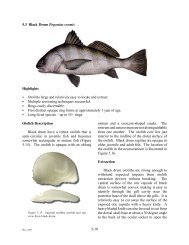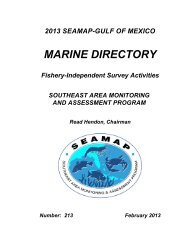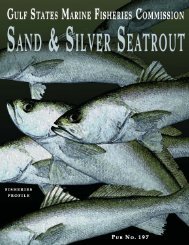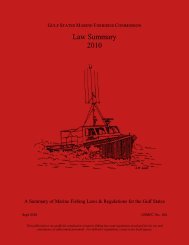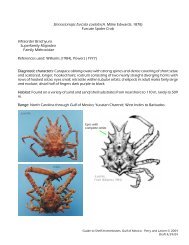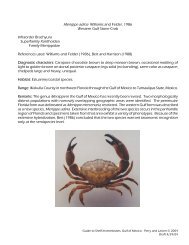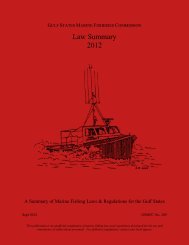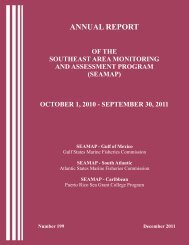Guidelines for Marine Artificial Reef Materials, Second Edition
Guidelines for Marine Artificial Reef Materials, Second Edition
Guidelines for Marine Artificial Reef Materials, Second Edition
You also want an ePaper? Increase the reach of your titles
YUMPU automatically turns print PDFs into web optimized ePapers that Google loves.
experts undertaking the demolition is recommended along with USCG coordination.<br />
Potential impacts to marine mammals, turtles, and fishes should be considered.<br />
• Develop and implement cleaning standards <strong>for</strong> pollutants known to occur on ships. Require<br />
testing <strong>for</strong> PCBs on boats and ships constructed prior to 1975 (when PCB manufacture<br />
ended). Require an asbestos inspection. Identified asbestos that is secured or encased may<br />
be left undisturbed, and in place prior to sinking (EPA does not consider asbestos a hazard<br />
in the marine environment but it can be a health hazard when airborne. Since sinking of a<br />
vessel is considered structural modification of a facility, ships to be sunk as artificial reefs<br />
fall under requirements <strong>for</strong> asbestos inspection).<br />
• Develop and coordinate inspection standards with EPA, USCG, and affected state regulatory<br />
agencies.<br />
• Liability issues must be recognized and addressed by permittees who are required to provide<br />
long-term responsibility <strong>for</strong> materials on their permitted artificial reef sites, including ships.<br />
Demonstration of this responsibility could include liability insurance, posting a bond or other<br />
indemnifying instrument to ensure resolution of liability issues associated with the towing,<br />
cleaning and sinking of ships on state submerged lands. This liability includes damages<br />
caused by movement of the materials during storm events.<br />
• Use the consistency process under the Coastal Zone Management Act to ensure vessels<br />
constructed as reefs in permitted sites in the Exclusive Economic Zone (EEZ) are held to the<br />
same standards as vessels placed in adjacent state waters.<br />
• Reassess all constraints that may be placed on sinking a ship (i.e. minimum depth, distance<br />
from shore, complexity of vessel that may require additional technical assistance, stability<br />
requirements, vessel orientation, cost, time involved in project, etc.), and decide early on<br />
whether one or more of these constraints will result in a final outcome that will not be<br />
successful in achieving the project’s objectives.<br />
Federal Vessel <strong>Reef</strong>ing Program Development Recommendations<br />
• Gulf and Atlantic <strong>Marine</strong> Fisheries Commissions and Councils should investigate possible<br />
federal programmatic alternatives to the multi-year drawn out process of securing piecemeal<br />
individual MARAD vessels under current circumstances, that result in very high<br />
expenditures per vessel.<br />
• Recommend if a federally sponsored large-scale military ship-sinking program becomes a<br />
reality, then ef<strong>for</strong>ts to coordinate such a program should occur at the national level through<br />
the ASMFC and GSMFC. This would avoid interstate competition <strong>for</strong> vessels and<br />
preferences given to those states that have more substantial reef funding resources than<br />
others.<br />
-39-




